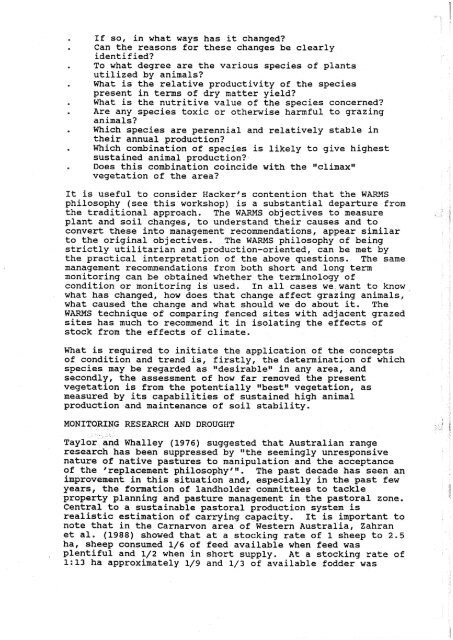soil-conservation-people-religion-and-land.pdf - South West NRM
soil-conservation-people-religion-and-land.pdf - South West NRM
soil-conservation-people-religion-and-land.pdf - South West NRM
Create successful ePaper yourself
Turn your PDF publications into a flip-book with our unique Google optimized e-Paper software.
If so, in what ways has it changed?<br />
Can the reasons for these changes be clearly<br />
identified?<br />
To what degree are the various species of plants<br />
utilized by animals?<br />
What is the relative productivity of the species<br />
present in terms of dry matter yield?<br />
What is the nutritive value of the species concerned?<br />
Are any species toxic or otherwise harmful to grazing<br />
animals?<br />
Which species are perennial <strong>and</strong> relatively stable in<br />
their annual production?<br />
Which combination of species is likely to give highest<br />
sustained animal production?<br />
Does this combination coincide with the ltclimaxflt<br />
vegetation of the area?<br />
It is useful to consider Hacker's contention that the WARMS<br />
philosophy (see this workshop) is a substantial departure from<br />
the traditional approach. The WARMS objectives to measure<br />
plant <strong>and</strong> <strong>soil</strong> changes, to underst<strong>and</strong> their causes <strong>and</strong> to<br />
convert these into management recommendations, appear similar<br />
to the original objectives. The WARMS philosophy of being<br />
strictly utilitarian <strong>and</strong> production-oriented, can be met by<br />
the practical interpretation of the above questions. The same<br />
management recommendations from both short <strong>and</strong> long tern<br />
monitoring can be obtained whether the terminology of<br />
condition or monitoring is used. In all cases we:want to know<br />
what has changed, how does that change affect grazing animals,<br />
what caused the change <strong>and</strong> what should we do about it. The<br />
WARMS technique of comparing fenced sites with adjacent grazed<br />
sites has much to recommend it in isolating the effects of<br />
stock from the effects of climate.<br />
What is required to initiate the application of the concepts<br />
of condition <strong>and</strong> trend is, firstly, the deternination of which<br />
species may be regarded as lldesirabletg in any area, <strong>and</strong><br />
secondly, the assessment of how far removed the present<br />
vegetation is from the potentially llbestw vegetation, as<br />
measured by its capabilities of sustained high animal<br />
production <strong>and</strong> maintenance of <strong>soil</strong> stability.<br />
MONITORING RESEARCH AND DROUGHT<br />
Taylor aid Whalley (1976) suggested that ~ustralian range<br />
research has been suppressed by "the seemingly unresponsive<br />
nature of native pastures to manipulation <strong>and</strong> the acceptance<br />
of the 'replacement philo~ophy~~~. The past decade has seen an<br />
improvement in this situation <strong>and</strong>, especially in the past few<br />
years, the formation of l<strong>and</strong>holder committees to tackle<br />
property planning <strong>and</strong> pasture management in the pastoral zone.<br />
Central to a sustainable pastoral production system is<br />
realistic estimation of carrying capacity. It is important to<br />
note that in the Carnarvon area-of western ~ustralia, Zahran<br />
et al. (1988) showed that at a stocking rate of 1 sheep to 2.5<br />
ha, sheep consumed 1/6 of feed available when feed was<br />
plentiful <strong>and</strong> 1/2 when in short supply. At a stocking rate of<br />
1:13 ha approximately 1/9 <strong>and</strong> 1/3 of available fodder was
















